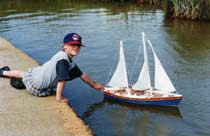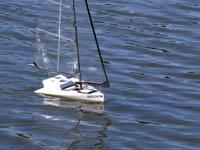|
A desirable outpost, a stunning windjammer. North Carolina oyster sharpies and Harban’s most exclusive little yacht klub
At the back of the house is the
shed, or D'Arcy's boathouse
as it is commonly known
That inland outpost where
things one day he just knows
he will need,
share space with other things
he's never needed but
thought he would,
Where boxes and containers that
'might just come in useful',
things for making things,
masts and spars, lead for keels,
tools, old broken toys,
paint-stiff brushes,
model yachts and other
things desirable
share space and silent company
with bugs in webs and spiders
and Archibald the old
and fairly sizeable giant Weta.
This is man's other home
for all sorts of bits and bobs,
odds n'ends,
whajamacallits
wossnames and 'thingies',
D'Arcy's desirable outpost.
Mark Steele
He called himself `Harban and told me he was the founder and `Commodore for life’ of the smallest yacht club, `his club sailing the tiniest sailing boats known to man’. `A recluse type’ he described himself as, and his club (which he stressed was spelt as klub) was on a small island in Scotland’s outer Hebrides and was where he sails his simply constructed free-sailing vessels eight to ten inches long. Since he said he that he restricts membership to one, by my calculations and from how he talked he was the only member. That’s pretty exclusive alright, I guess.
Harban actually lives in …” Wait ! Wait ! - you better not mention where I live” (he quickly added on the phone) spends two weeks each year in summer on the little island the name of which I am unable to tell you as here again I was sworn to secrecy. There he canoes, fishes, sails his little boats then leaves everything with a lady friend (which surprise surprise, he doesn’t mind my mentioning) for safe keeping. She lives on a larger island `round about’, close, near (who other than ‘Harban’ really knows ?) and he aint telling !
His telephone call to me took place in January 2007 and I’m still waiting for the promised photographs of his model sailboats which probably will never arrive. He said that he reads my column on Duckworks. Was he just having me on or was he a fugitive in hiding either from the law or from an irate husband, perhaps of his ladyfriend? I will probably never know much more other than he seemed to have a tiny bit of a Scottish accent… oh yes, and he told me that his wife had left him many, many years back. (Well that doesn’t surprise me, she probably wasn’t allowed to know his real name!) Come on Harban, I gave you my address so send me some photos… even if you have to wear a mask! Use that `didgertal’ camera you told me you bought!
 |
|
I have never met Keith Hummerstone of the UK but we have repeatedly been in touch from way back from the years of my magazine, Windling World when he built two lovely RC sailing models of Ellen MacArthur's world-rounding boat Kingfisher. Last year Keith built a fine display model of a Classic Swan sailing yacht (in photos above) with superb detail just as the owner had fitted out the fullsize Class 40 that he sails in Cowes. Built to a larger scale and with radio gear fitted, I can't help thinking what an even more stunning sight such a model would be on the water.
 |
|
 |
"And this is my boat, this very schooner that I am holding" (the young man in the photograph above, left) could well be saying. Well, he would have to talk to Jacqui Wellington in Auckland, it's builder and owner I'd say, but dreams are free and there's no harm in wishing. Seen above in the second photograph is the new 50" Marblehead from Tippecanoe, nicely photographed scuttling along in American waters, while in the third photograph can be seen and absolutely huge hull for a model of Heath's Condor proposed by the gentleman holding it in an Auckland,
New Zealand garden.
Athena was built by Royal Huisman for software developer, Jim Clark. At 89 metres from the bowsprit to the aft deck (with a waterline measurement of 61 metres) she is the world’s largest privately owned sailing yacht. A model built by Aucklander, Derek Nicholson and launched at Onepoto lake on 23rd August last year is seen in three of the photos above. Athena was the Goddess of the Sea and Zeus of the sail and the model is intricately detailed with just a few crewmen minutely modelled out of wood
`Twenty years from now you will be more disappointed
by the things you didn’t do than by the ones you did do,
so throw off the bowlines, sail away from the safe
harbor, catch the tradewinds in your sails, explore,
dream, discover’ Mark Twain
 |
|
 |
|
An exciting boat this, a 50” North Carolina Oyster Sharpie schooner, the one you are seeing built and owned by Tom Pratt. The exciting things is that a laser cut `frame only’ kit with a set of instructions and a sailplan is available at a nominal cost. If you are seriously interested, email tomsprotoshop@embarqmail.com for details, and add the subject line “Sharpie kit”. Tom and his brother Dick have built and sail really beautiful Bluenose schooners, but was so impressed at how well the sharpie schooners performed at the Solomon Island Model Boat Club regatta at the Calvert Museum, this led to a sharpie building programme with a senior model builders group in the Cincinnati area. Tom (extreme left in the photo) has found this so rewarding that he is sharing this unique boat with others.
I personally have always been attracted to a sharpie, my Spencer schooner, Fijipsy Jack being one and I would love to see this design lead to our Ancient Mariners developing a few of this particular North Carolina oyster boat before too long in Auckland.
That would be great but I doubt it will happen.
 |
|
|
A Footy or three, the first (above, bottom) equipped with a `reach for the sky’ lateen swing-rig, the second one (above, left), schooner-rigged with colourful sails. As racing takes a grip on this fledgeling class of boat originally conceived as a scale design fun boat more for cruising or windling than for competition, I wonder whether it will be modified until it looketh totally different. Are larger and larger rigs a likely development, and longer and deeper keels? In the United Kingdom, one hundred Footy boats are now registered which I would say suggests more than just a little flurry of interest, however there will be considerable drop-off when many lose interest and or go for larger boats, or find that their boat is not competitive or feel that their expectations differ from what was envisaged at the outset. In my humble opinion, the Footy should be promoted as a genuine little cruising boat that looks like one. Richard Gross's Footy shown top right
photograph being an example.
 |
|
Having been `uncool’ and sounding `anti serious racing’ I turn to a delightfully different Footy called ARROW shown above that looks like a jet fighter and has been designed and produced by Auckland Ancient Mariner, Ron Rule (above) who loves to be different and to push the barriers. Ron believes that if people had not done that, we would all be sailing coracles today. Built of balsa, Arrow is beautifully finished and early tests on the water have shown the boat to be quite fast. In addition to the new Footy Ron is also developing, rather than a canting keel, a canting mast system, with tests in an old Footy hull proving to be quite encouraging.
They keep on coming! The urge to build and sail the graceful square-rigged boats of the `yesteryears’ is certainly growing, the result being the appearance on ponds here and there of these wonderful reminders of our past. Behold here, the windjammer Judith Kate by Neville Wade of the Bristol area of Britain, whom some will remember produced another square-rigged model (the Ann Louise) which appeared in this column not too long ago. The Judith Kate, named after their son’s partner,was based on a vessel called the Herzogin Cecilie a four-masted barque built in 1902 as a cargo carrying training ship for a German shipping line. The vessel had a waterline length of some 310 feet and was capable of carrying around 4,000 tonnes of cargo. After a colourful career too lengthy to mention here, suffice to say that she was wrecked off the coast of South Devon, UK in 1936. (No wonder I never heard about it… I was only two! Editor)
Built at 1:87th scale, the size determined in order to have the model accommodated in Nev’s car, the JK is 1300mm from bowsprit to stern rail. Building from a plan drawn from the original builders’ plans, the model was constructed using conventional plank on frame techniques and waterline tests revealed that she needed 8kg in order to float to the fully loaded waterline and a detachable keel and a rudder was made oversize to ensure that she steered effectively. Masts and spars are of simple dowel. Since I rarely if ever go into detailed information about the technical areas, in this case can I suggest that you obtain a copy of the September 2007 issue of Marine Modelling International in which there are no less than five pages on this wonderful model. Neville Wade is entranced over square-riggers, and his two models enables those lucky enough to see them sail in Bristol, the opportunity to feel the power of the real thing, certainly to imagine how those on board would have felt as they carried 400 tonnes of cargo the 12,000 miles from Australia to Europe in 90 to 100 days on wind power alone.
Daring to be different with spotty sails, and looking at first glance like a runaway Dalmation `pooch' is this yacht which appears to be a Seawind. Someone in Canada sent me a photoprint of questionable quality and whose boat it it was and where it was taken I don't know. The second photographs is one of the covers of Bob Hicks wonderful monthly magazine, Messing About In Boats, covering a wide range of boating activity areas. A good read that I enjoy immensely. The third photograph could be titled The old and the new and is the work of a favourite International yacht racing lensman, (Carlo Borlenghi) and was taken at the Rolex sponsored Farr 40 Championship Regatta off Copenhagen, Denmark last year. The racing yacht is Alinghi, the old sailing ship unfortunately un-identified. (Photo by Rolex/Carlo Borlenghi)
|

Auckland, New Zealand Ancient Mariner, Bob Walters, good friend
of those whom he sailed with) on 5th June slipped moorings and passed
away in hospital after a prolonged illness. He is seen in the photograph
above with his good mate and late Dogadore of the group, MO in better
days. A keen builder and windling model yacht sailor, Bob leaves behind
a wife, Pam and adult offspring and is sadly missed.
|
|

